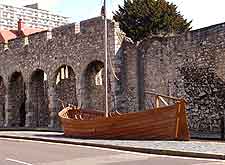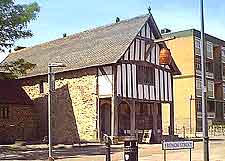Southampton History Facts and Timeline
(Southampton, Hampshire, England)

Southampton started out life as a Roman town. Known as Clausentum, it stood on one side of the River Itchen. In the mid 6th century, the Saxon town of Hamwic was founded on the other side of the river. At first, the town prospered. By the 10th century, though, it had started to fall into decline, probably because of damage inflicted by a series of Danish raids.
The arrival of the Normans in the 11th century ushered in a period of growth for Southampton. Religious buildings sprang up in the town, including St. Michael's Church and the Maison Dieu Hospice.
Medieval Times
By the 13th century, Southampton had acquired its own stone castle, city gates and merchant houses. At this time, it was one of the busiest ports in England. Much of the town's prosperity was down to its trade in such luxury goods as spices and silk. Southampton also had a burgeoning shipbuilding industry.
During the Middle Ages, Southampton was at the centre of many key naval events. In 1346, King Edward III and the Black Prince sailed from Southampton for the Battle of Crecy. In 1415, Henry V's army sailed from here to do battle at Agincourt. However, this era of history wasn't without its setbacks. In 1348, the Black Death killed a quarter of the overall population. In subsequent plagues, many more townsfolk died.

From Declining Port to Fashionable Spa
At some point during the 16th century, the sea trade went into decline. There were many possible reasons, including the loss of its monopoly in the export of tin and lead. The wine trade was seen as one possible way to restore the town's fortunes. In 1554, it was decreed that French Malmsey wine could only be imported through Southampton. However, it had little effect and by the end of the 17th century, the town had slipped into an even more parlous state.
Then, in 1750, the town was fortuitously visited by Prince Frederick. He enjoyed his visit so much that he kept on coming back. Thanks to his royal patronage, Southampton became a popular sea bathing resort. By 1762, it had recovered sufficiently to possess a number of fine houses. The wine trade also started to recover. By the end of the 18th century, Southampton had begun to spread north of Bargate. An Assembly Rooms and theatre were built for the entertainment of its visitors and residents.
From the Victorian Era to the Present Day
The Victorian era saw vast improvements, particularly in its communications with the outside world. The
London railway line reached Southampton in 1840. Two years later, the first ship was to arrive in the Outer Dock, which is part of the present-day Eastern Docks.
In 1907, the White Star Line started to operate sailings from the port. Five years later, there were to be tragic consequences when RMS Titanic left Southampton, only to sink on her maiden voyage.
Southampton was to become one of the heaviest bombed cities in the Second World War. As a military port and the home of the legendary Spitfire planes, it was an obvious target for attack. Rebuilding after the war was a huge undertaking.
In 1964, Southampton was granted city status. This was to be the start of a new phase of the city's history, with the subsequent construction of the Container Docks.
 Southampton started out life as a Roman town. Known as Clausentum, it stood on one side of the River Itchen. In the mid 6th century, the Saxon town of Hamwic was founded on the other side of the river. At first, the town prospered. By the 10th century, though, it had started to fall into decline, probably because of damage inflicted by a series of Danish raids.
Southampton started out life as a Roman town. Known as Clausentum, it stood on one side of the River Itchen. In the mid 6th century, the Saxon town of Hamwic was founded on the other side of the river. At first, the town prospered. By the 10th century, though, it had started to fall into decline, probably because of damage inflicted by a series of Danish raids.